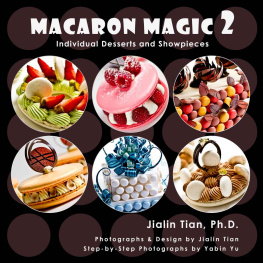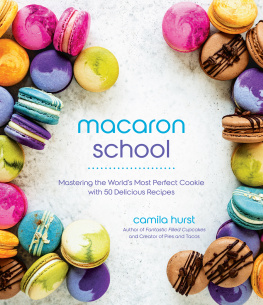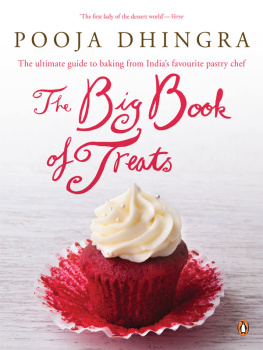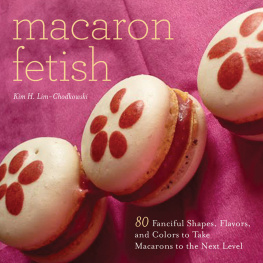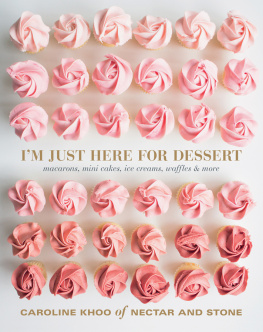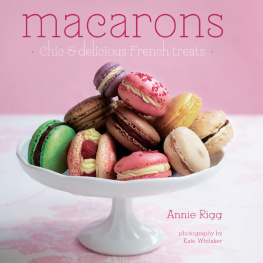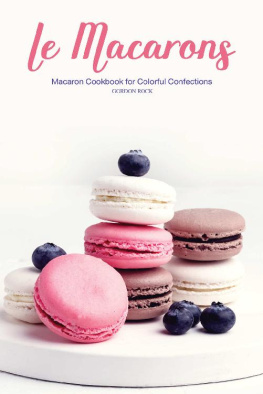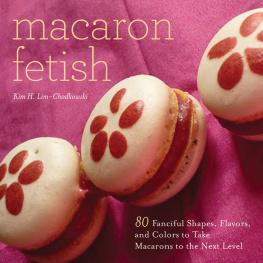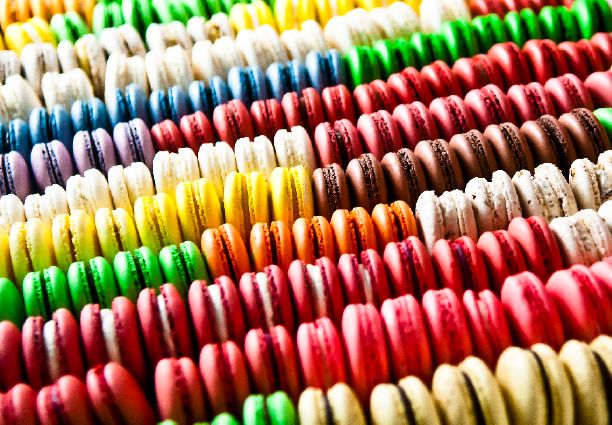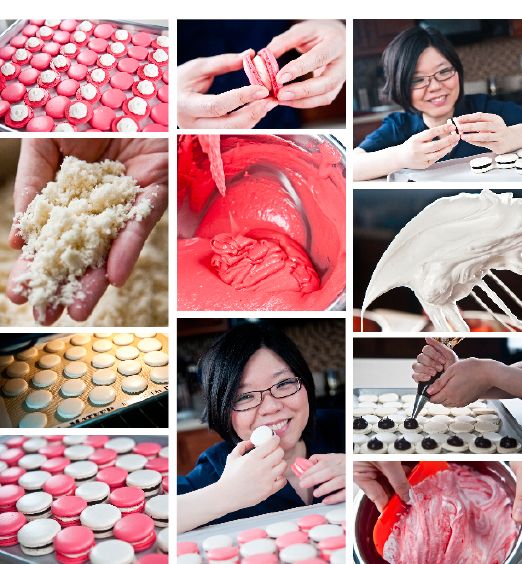Macaron Magic
Jialin Tian, Ph.D.
Photographs and Design by Jialin Tian
Step-by-Step Photographs by Yabin Yu
Macaron Magic
Jialin Tian, Ph.D.
Copyright 2011 by Jialin Tian
Photographs copyright 2011 by Jialin Tian and Yabin Yu
All rights reserved. No part of this book may be reproduced or transmitted in any form or by any means, electronic or mechanical, including photocopying, recording, or by any information storage and retrieval system, without permission in writing from the publisher.
Disclaimer: While every precaution has been taken in the preparation of this book, the publisher and author assume no responsibility for errors or omissions, or for damage or loss resulting directly or indirectly from the use of the information contained herein.
Published in the United States by
Jayca Inc.
P. O. Box 2451
Poquoson, VA 23662
USA
Photographs and styling: Jialin Tian
Step-by-step photographs and authors photographs: Yabin Yu
Book design and layout: Jialin Tian
Production manager: Yabin Yu
www.macaronmagic.com
ISBN: 978-0-9837764-1-3 (Kindle Edition)
First Edition
To my mother, Yabin
Introduction
A lmonds, sugar, egg whites, and magic! Although its origin is debatable, we can all agree that the Parisian macaron we know today is a symphony of sweet delight with endless possibilities. At first glance, you see a round sandwich-like miniature pastry with a glossy, smooth, and colorful exterior. A closer inspection shows that the macarons shiny thin shells are supported by airy, spongy feet underneath, which make the macaron look like a pair of disproportional button mushrooms. The two shells are held together by a mysterious interior soon to be discovered. Now you have seen enough, lets take a bite! The outer crust is slightly crisp but delicate, beneath the crust is moist and tender, the final crescendo ends on the velvety, smooth, and decadent center. The macaron is gone before you even realize it! Now you are eager to try another one, but who can blame you? No one can resist these rainbow-colored little gems filled with an array of sinfully delicious fillings.
I always imagined that Parisian macarons were discovered by accident. Imagine that in a dark and cramped kitchen an exhausted young apprentice works on the last batch of traditional macarons. His arms become robotic from performing the same repetitive movements. He folds the meringue into the almond paste when he is half conscious and half asleep. Before he knows it, its too late! The meringue was overworked and has collapsed. By now, he is fully awake and starts to become anxious; there is no time to make another batch! He is terrified by the imminent scrutiny of his master, but what can he do? Panicked, he quickly pipes out the macarons, loads them into the oven, and prays for the best. Imagine the relief he feels when the accident turns out to be an unexpected success. Like many accidental discoveries, it may take a remarkable event to stumble on success, but it takes an even more remarkable talent to recreate and perfect that success.
M aking the perfect macaron is no accident since many factors can affect the outcome of the final product. Variables such as the texture of the almond flour, the temperature and state of the sugar, the moisture content of the egg whites, and the viscosity of the macaron batter as well as random environmental variables such as ambient temperature and humidity can all play a crucial role in macaron baking. Fortunately, these factors can be controlled so that we can achieve a consistent result regardless of minor changes in baking conditions. Nevertheless, some trial-and-error experimentation may still be required.
I discovered the joy of pastry experimentation when I was a graduate student. At the time, I was working on my doctoral dissertation on the reconstruction of irregularly sampled interferograms for an imaging Fourier transform spectrometer, an optical instrument for remote-sensing satellite applications. Two years into my research, I became increasingly frustrated with not having found a solution. I started to question whether a solution even existed. That was when I began to bake. Making pastries helped me to see the problem from a fresh new angle. Sometimes, even when my baking experiment was disastrous, the process made me realize that a failed attempt brings me another step closer to success, assuming a finite number of solutions exist.
W ith the guidance of this book, I encourage you to try your hand at making these delectable treats at home, and dont feel frustrated even if they dont turn out the way you have envisioned on the first try. The book is divided into eight chapters. In the first chapter, we introduce the fundamental technique for making the perfect macaron shells. We discuss in detail how to control the three key factorstemperature, moisture, and viscosityto produce the perfect result every time. We present the concept of quasi-meringue in the most crucial step of macaron making. In the next six chapters, we explore some of the endless possibilities for making the most delicious macarons, from your favorite happy hour special to an exotic tropical paradise, from the land of coffee and tea to the morning bazaar, from an array of nutty transformations to a sweet-and-savory wonderland. In the final chapter, we celebrate the most memorable days of the year with macarons! From timeless classics to innovative creations to spectacular showpieces, these little wonders will definitely make a lasting impression. Finally, we have included a list of resources for the tools and ingredients used in this book.
T he macaron project would never have become a reality without the help of my mother, Yabin. From taking the step-by-step photographs to shopping for ingredients, from critiquing my photographs to helping out with the dishes, she has done it all! If I am a piano virtuoso, then she must be my backup orchestra; together we performed a concerto of irresistible wonders. An orchestra cannot perform without a stage manager, and that honor goes to my father Richard. I thank him for all the assistance he has provided during the making of this book; in addition, I want to thank him for always being on standby to offer a helping hand. My deepest appreciation goes to the chefs and instructors who have shared their invaluable knowledge and experience with me. My special thanks go to Chef Stphane Glacier for teaching me the art of making the perfect macaron. Finally, many thanks to my tasters and testers; its a tough job, but someone has to do it!


